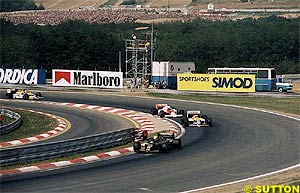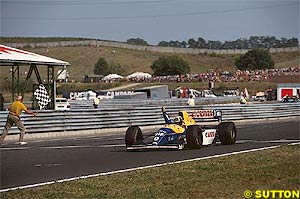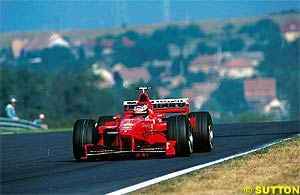
Atlas F1 Contributing Writer
Tight, twisty, dusty, hot, and with almost no places to overtake, the Hungaroring circuit is not among the favourites of the calendar for drivers, team members or spectators. However, the Hungarian track has provided some exciting Grands Prix throughout its 16 years of history. Journalist and historian Doug Nye looks back at the history of the circuit and reviews the most significant races held there
After World War 2, motor sport was slowly revived in Hungary, ultimately upon a modified street circuit in Budapest measuring 5.3kms per lap. In the 1960s a qualifying round of the important European Touring Car Challenge was held there, together with both international and national races for Formula 3 and Formula Vee.
During 1983, Bernie Ecclestone began discussions with the Hungarian government about the possibility of Formula One penetrating the communist bloc, and finding an 'outlet' for its multiple sponsors behind the 'Iron Curtain'. The potential for such a venture was obvious. A very significant proportion of Formula One's contemporary backers was the global tobacco industry. As the west's opposition to tobacco use became ever more energetic, alternative markets were being sought. The eastern European market, unembarrassed by the health scares and concerns of the leading capitalist nations, remained hugely receptive. The Hungarian government was prepared to embrace the circus, and construction began on an international standard artificial road racing circuit to host a modern Hungarian Grand Prix.
With prominent financial support from Phillip Morris's Marlboro tobacco brand the Hungaroring was completed and groomed for worldwide exposure in 1986. An agreement had been reached to stage a round of the FIA Formula One World Championship there for five consecutive years.
That year's inaugural Formula One World Championship-qualifying race on this new venue was won by Nelson Piquet in his Williams-Honda, but Ayrton Senna had led for a long way in his Lotus-Renault before the older Brazilian had nosed by in the downhill-entry 180-degree right-hander at the end of the pit straight. That corner would become the only point on the entire Hungaroring to be regarded - then and now - as a favourite overtaking point, 'favourite' in this context substituting pretty much for 'the only'.
In 1987, the irrepressible Piquet won his second consecutive Hungarian GP, driving a development of the same Williams-Honda. But this time it had been his teammate, Nigel Mansell, who had seemed set to win after leading for most of the distance, only to lose a rear wheel fixing and be forced into retirement.
The tight circuit then witnessed a tremendous duel in the 1988 Grand Prix between the McLaren-Honda teammates, Ayrton Senna and Alain Prost. 'Tadpole' had shouldered out the startled Brazilian in an intimidating move of which the great Brazilian himself would have been proud, avalanching down into that first corner past the pits, only to run wide on the exit and enable Senna to lance back ahead. Now forewarned, Senna spent the rest of the race hovering mid-track down into that first corner, watching his mirrors like a hawk and keeping that inside line thoroughly covered. Prost was never afforded another chance, and the outcome was settled.
There were 24 laps to run. On lap 58 Mansell in his superbly tailored Ferrari was right on Senna's tail when they rushed up behind the backmarker Onyx driven by Stefan Johansson. Senna ran perhaps a fraction to close to the hapless Swede, the great racing animal within Nigel Mansell read the situation instantaneously and dived by. With his only route round Johansson occupied by the fleeting Ferrari, Senna had to back off. Mansell was past and gone. Senna - concerned at his Honda engine's high fuel consumption, settled for second and Ferrari won what was in effect its first Hungarian GP since 1936.
Senna was again the first loser at the Hungaroring in 1990. After bouncing off Alessandro Nannini's Benetton the Brazilian took off after surprise race leader Thierry Boutsen's Williams-Renault. He scorched around the empty track to close on the Belgian's tail, but instantly his lap times stretched by a couple of seconds. Few onlookers gave Boutsen a chance against the avenging angel on his exhausts, but such was the cramped nature of the Hungarian circuit that in his well-geared Williams he could stretch just sufficient cushion along the pit straight to prevent Ayrton diving by into the first corner, and would then deny him the line throughout the remainder of the lap. Any and every move Senna made to depart from that single grippy groove saw the McLaren begin to slide. Thierry Boutsen made not a single mistake throughout the remainder of the race, and as he won it was a supremely frustrated and fuming Brazilian who finished second in his wake.
Senna would then win both following Hungarian Grands Prix, in 1991 and 1992. In 1993 Briton Damon Hill finally scored his very first, rather overdue Formula One victory there in the latest Williams-Renault iteration - after team leader Alain Prost had stalled his sister car on the grid before the parade lap, and had been obliged to start from the back of the field. Before that 1993 race the Hungaroring circuit had been modified as an underground spring had to be diverted to prevent flooding, and this work had reduced the course's official lap length to 3.968kms.
The British driver reversed the situation in 1995, when he won again for Williams-Renault, and then in 1996 Hill and his new teammate Jacques Villeneuve fought a fierce internecine battle resolved on the final lap, effectively, in the young French-Canadian's favour.
The nature of the Hungaroring very much dictated the character of the races run there. Only one overtaking manoeuvre - the inside lunge into the first corner past the pits - was considered to be viable, and so pit-stop strategy there has always been of even greater significance than on any other World Championship venue. With the pitlane rejoining the main straight in the braking area for the first corner, another factor whose significance is magnified there is a great getaway after a pit stop. Re-entry to the track enables a rejoining car to block the only safe line for a fast-running rival, buying precious seconds in which to retain a place, and then bring-in fresh tyres round the back-leg before the next brief blast down into that solitary favoured overtaking zone.
In 1997 Damon Hill was driving for the unfancied Arrows team, yet he utterly dominated for much of the race and looked like winning it on sudden merit until a late-race loss of hydraulic pressure left him limping along on part throttle and stuck in gear - Villeneuve deprived him of first place on the final lap, to win again, Hill second.
And so we were into races of recent memory. The Williams-Renault stranglehold upon the Hungarian GP was broken in 1998 by Michael Schumacher of Ferrari, or perhaps that success should go down in the record books as Ross Brawn's since it was his on-the-hoof pit stop strategy which achieved the apparently impossible and brought yet another victory to Maranello.
In that race Ross switched his numero uno from a two-stop to a three-stop strategy, as race data unfolded to suggest this would be the fastest route to the finish on the harder of Goodyear's two alternative tyre compounds. The McLaren-Mercedes cars had qualified ahead of Schumacher on the grid. Burning his rear tyres down the pitlane after his third stop, Schumacher rejoined the circuit with some five seconds in hand over David Coulthard's MP4/13, and the German maintained this cushion to secure brilliant victory. "It was..," he declared, "..very much a race run at qualifying speed for me." Typically, without a speck of perspiration to be seen, or a hair out of place, quite unlike so many previous Hungaroring race winners.
Over the following two years - in 1999-2000 - McLaren-Mercedes-Benz dominated with their Finnish World Champion Driver, Mika Hakkinen triumphant. In 2001 Michael Schumacher won again for Ferrari - and this weekend, with those Championship titles now safely tucked away, who knows?
The only really significant motor race held in Hungary pre-World War 2 was the Budapest Grand Prix which was held in a park in the capital city in 1936. That race was run over 250kms distance or 50 laps, and Tazio Nuvolari of Italy won in his Scuderia Ferrari-entered Alfa Romeo, from the two German V16-cylinder Auto Unions of Bernd Rosemeyer and Achille Varzi.
 The new State-run 4.014km 'Hungaroring' circuit had been constructed near Magyorod, 20kms north-east of Budapest. The circuit was extremely tight and twisty, making the forthcoming Hungarian Grand Prix one of the slowest, longest and most punishing of the entire calendar. Initial reaction to the new course was not particularly flattering. Its tortuous layout was considered too tight, too twisty, too Mickey Mouse. The site was sandy and dusty, and off the racing line the Hungaroring's 'marbles' made the North Sea sand dune Zandvoort circuit on a windy day look grippy.
The new State-run 4.014km 'Hungaroring' circuit had been constructed near Magyorod, 20kms north-east of Budapest. The circuit was extremely tight and twisty, making the forthcoming Hungarian Grand Prix one of the slowest, longest and most punishing of the entire calendar. Initial reaction to the new course was not particularly flattering. Its tortuous layout was considered too tight, too twisty, too Mickey Mouse. The site was sandy and dusty, and off the racing line the Hungaroring's 'marbles' made the North Sea sand dune Zandvoort circuit on a windy day look grippy.
 By 1989 Mansell was driving for Ferrari, and he took the remarkably - atypically? - intelligent tactical decision after an abortive Friday qualifying period to devote the Saturday period to perfecting a race set-up for his Tipo 640 car, instead of busting a gut to compete for pole position. Starting from row six of the grid on Sunday, he passed the pits ending the first lap in 8th position. By lap 11 he was 7th, by lap 30 he was 3rd, and Patrese's retirement from the race then saw him inherit 2nd behind Senna.
By 1989 Mansell was driving for Ferrari, and he took the remarkably - atypically? - intelligent tactical decision after an abortive Friday qualifying period to devote the Saturday period to perfecting a race set-up for his Tipo 640 car, instead of busting a gut to compete for pole position. Starting from row six of the grid on Sunday, he passed the pits ending the first lap in 8th position. By lap 11 he was 7th, by lap 30 he was 3rd, and Patrese's retirement from the race then saw him inherit 2nd behind Senna.
 Damon Hill's great World Championship rival Michael Schumacher subsequently scored his first Hungarian GP victory for Benetton-Ford in 1994, presumably with its onboard management box of tricks working its trickery within the letter of as many technical regulations as were then scrutineerable.
Damon Hill's great World Championship rival Michael Schumacher subsequently scored his first Hungarian GP victory for Benetton-Ford in 1994, presumably with its onboard management box of tricks working its trickery within the letter of as many technical regulations as were then scrutineerable.
 Another significant factor at the Hungaroring in high summer is also the central European heat. That raceday in 1997 Goodyear's tyres overheated and blistered unpredictably, contributing to the Arrows' remarkable performance.
Another significant factor at the Hungaroring in high summer is also the central European heat. That raceday in 1997 Goodyear's tyres overheated and blistered unpredictably, contributing to the Arrows' remarkable performance.
Please Contact Us for permission to republish this or any other material from Atlas F1.
|
Volume 8, Issue 33
Atlas F1 Exclusive
Chemistry Class at Clermont-Ferrand
Giancarlo Fisichella: Through the Visor
Hungarian GP Preview
The Hungarian GP Preview
Local History: Hungarian GP
Hungary Facts, Stats and Memoirs
Tech Focus: GP Racing Car Engine
Columns
The Hungarian GP Quiz
Rear View Mirror
Bookworm Critique
Elsewhere in Racing
The Grapevine
> Homepage |